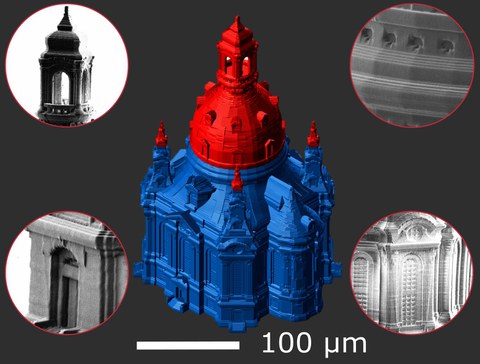20.05.2022
HETEROMERGE: TUD-Ausgründung entwickelt Lösungen für hochpräzisen Multimaterial-3D-Druck

Automatisierter Multimaterial-3D-Druck, feiner als ein menschliches Haar durch Erweiterung des 2-Photonen-Laserdirektschreibens mittels automatisiertem Materialwechsel. (Modell der Frauenkirche Dresden mit Mikroskopaufnahmen gedruckter Details in Vergrößerung)
Im Rahmen eines EXIST-Forschungstransfers entwickelt das Team von HETEROMERGE eine Technologie für den automatisierten Materialaustausch für Hochpräzisions-3D-Drucker zur Marktreife. Dadurch werden auch im Bereich extrem kleiner Strukturgrößen von bis zu 100 Nanometern Multimaterialdrucke möglich.
Mit dieser Innovation ist das Team beim diesjährigen Sächsischen Gründerpreis der Innovationsplattform des Freistaates Sachsen - futureSAX - angetreten. Bis zum 31.05.2022 kann beim futureSAX-Publikumspreis noch für HETEROMERGE abgestimmt werden.
3D-Druck (oder additive Fertigung) gehört zu den Themen, die unsere Zukunft maßgeblich und nachhaltig verändern. Dies gilt auch für die Fertigung zukünftiger Generationen von Mikrosystemen. Dabei werden für den 3D-Druck ähnlich leistungsfähige Verfahren benötigt, wie sie heute beispielsweise in der Halbleiterfertigung für ebene Strukturen vorhanden sind. Zwei-Photonen-Polymerisation (2PP) ist eines der schnellsten und gleichzeitig höchstauflösenden Verfahren der additiven Fertigung. Mit 2PP lassen sich 3D-Drucke feiner als ein menschliches Haar herstellen – bisher jedoch nur aus einzelnen Materialien. Das beschränkt die Einsatzfelder und Möglichkeiten dieser faszinierenden Technologie enorm. Für Drucke aus mehreren Materialien und damit mehreren Eigenschaften, muss der Austausch gegenwärtig manuell erfolgen – ein sehr arbeits- und zeitaufwändiger und somit teurer Prozessschritt. Weiterhin muss der Druck mit dem neuen Material genau an der Stelle fortsetzen, wo er mit dem vorherigen Material endete. Bei Strukturgrößen im Sub-Mikrometerbereich ist diese Neuausrichtrichtungsgenauigkeit manuell jedoch nicht zu erreichen.
HETEROMERGE hat ein patentiertes Verfahren für den automatisierten Materialaustausch für 2PP-Druckersysteme entwickelt, das erstmals Multimateriadrucke mit Strukturgrößen bis zu 100 Nanometer bei höchster Neuausrichtungsgenauigkeit des Druckkopfes von bis zu 10 Nanometern nach dem Materialwechsel unabhängig vom Drucksubstrat ermöglicht. Der automatisierte Materialwechsel ist dabei noch bis zu zehn Mal schneller als der fehleranfällige manuelle Austausch. Der 3D-Druck ist sowohl auf allen gängigen Drucksubstraten der Mikrosystemfertigung (z. B. Silizium, Glas) als auch auf passiven und aktiven Strukturen wie zum Beispiel integrierten Lichtwellenleitern, LEDs, Lasern, Optokopplern oder optischen Fasern möglich. Die Technologie bildet einen „Missing Link“ für vielfältigste neue Anwendungsbereiche, insbesondere in den Bereichen Mikrooptik und -fluidik sowie im Photonics Packaging, aber auch im Bereich des Tissue-Engineerings und wird damit zum Enabler für den industriellen Einsatz der Hochpräzisions-Druckersysteme.
HETEROMERGE geht aus der Forschungsgruppe MESO3D - Mesoscopic 3D Systems hervor. Die Gruppe unter der Leitung von Dr. Robert Kirchner wurde im Herbst 2021 in den Forschungscluster Center for Advancing Electronics Dresden (cfaed) integriert. Seit Mai 2021 bereitet das Team im Rahmen der Förderung EXIST-Forschungstransfer des Bundesministeriums für Wirtschaft und Klimaschutz den Markteinstieg vor. Unterstützung bei der Antragstellung fanden die Wissenschaftler bei dresden|exists, dem Start-up-Service, der Hochschulen und Forschungseinrichtungen. Die Berater:innen begleiten das Team auch weiterhin durch den gesamten Ausgründungsprozess.
Das Gründungsteam hat mehrere Jahrzehnte Erfahrungswissen in den Bereichen hochauflösender 3D-Druck, Fluidik, Polymerchemie bzw. Materialwissenschaften, Konstruktion und besitzt Gründungs- und Industrieerfahrung. HETEROMERGE sucht aktuell weitere Teamkolleg:innen, die begeistert daran mitwirken möchten, die revolutionäre Technologie zur Marktreife zu führen. Derzeit betrifft das insbesondere die Bereiche Hard- und Softwareentwicklung sowie Materialwissenschaften und Fluidik.
Abstimmen beim futureSAX Publikumspreis (bis 31.05.2022):
https://www.futuresax.de/gruenden/saechsischer-gruenderpreis/publikumspreis-2022?voting-id=734
HETEROMERGE:
www.heteromerge.de
Twitter: @heteromerge
Forschungsgruppe MESO3D:
https://cfaed.tu-dresden.de/kirchner-group/home
Kontakt:
Dr. Robert Kirchner
Projektleiter HETEROMERGE
TU Dresden, cfaed - Center for Advancing Electronics Dresden
Tel.: +49 351 463-43966
Matthias Hahndorf
Wissenschaftskommunikation
TU Dresden, cfaed - Center for Advancing Electronics Dresden
Tel.: +49 351 463-42847
E-Mail:
